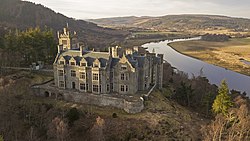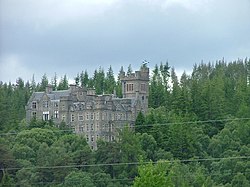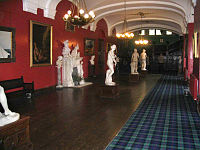Carbisdale Castle
| Carbisdale Castle | |
|
Ross-shire | |
|---|---|
 Carbisdale Castle | |
| Location | |
| Grid reference: | NH57439544 |
| Location: | 57°55’32"N, 4°24’32"W |
| History | |
| Built 1905-1917 | |
| Information | |
Carbisdale Castle was built in 1907 for the widowed Duchess of Sutherland on a hill on the south shore of the Kyle of Sutherland, in Ross-shire and across from Invershin (the latter in Sutherland). Until 2011, the castle was used as a youth hostel, operated by the Scottish Youth Hostels Association.
The castle stands in Easter Ross, to the north of Culrain, and some three miles north-west of Bonar Bridge. It is built in the Scots Baronial style, and is protected as a Category B listed building.[1] The hostel closed for repair in 2011, and was later sold, in September 2016, to FCFM Group Ltd who stated they intend to make it "a world-class private residence".[2]
History
The castle was built between 1905 and 1917 for Mary Caroline, Duchess of Sutherland, the second wife of George Sutherland-Leveson-Gower, 3rd Duke of Sutherland, whom she married in 1889. She is better known as "Duchess Blair" because of her first marriage to Captain Arthur Kindersely Blair of the 71st Highland Light Infantry, who died in a hunting accident in 1883 near Pitlochry. The marriage was not well liked in the Sutherland family. When the Duke died in 1892 his will, in favour of the Duchess, was contested by his son and heir, Cromartie. In a court process that followed, the Duchess was found guilty of destroying documents and was imprisoned for six weeks in London.

Eventually, the Sutherland family came to an agreement giving Duchess Blair a substantial financial settlement. Furthermore, the family agreed to build a castle for the Duchess, as long as it was outside of the Sutherland lands. The Duchess employed a firm of Ayrshire builders and work started in 1906 on a site in Ross-shire, just outside the Sutherland lands. It was located on a hillside to be visible to a large part of Sutherland, especially the main road and rail line which the Sutherland family would have to use to travel south. Thus it became known as the "Castle of Spite" as it was widely considered that the Duchess located the castle there to spite her husband's family and the settlement agreement.[3] This is further supported by the fact that the castle's tower only has clocks on three of its four faces - the side facing Sutherland is blank, supposedly because the Duchess did not wish to give the time of day to her former relatives.[3]
Colonel Theodore Salvesen, a wealthy businessman of Norwegian extraction, bought the castle in 1933. He provided the castle as a safe refuge for King Haakon VII of Norway and Crown Prince Olav, who would later become King Olav V, during the Nazi occupation of Norway in the Second World War. During that time the castle was also used to hold important meetings. King Haakon VII made an agreement at the Carbisdale Conference on 22 June 1941, that the Russian forces, should they enter Norwegian territory, would not stay there after the war. Three years later, on 25 October 1944, the Red Army entered northern Norway and captured thirty towns, but later, if with noticeable reluctance, withdrew according to the terms of the agreement.
After the Colonel died his son, Captain Harold Salvesen, inherited the castle and gave its contents and estate to the Scottish Youth Hostels Association. Carbisdale Castle Youth Hostel opened to members on 2 June 1945.
Following frost damage, the hostel closed for repairs in February 2011. Further structural damage was discovered, and over £2 million has been spent on repairs.[4]
Towards the end of 2014, Carbisdale Castle was advertised for sale by the SYHA,[5] and 17 marble sculptures and 36 19th Century paintings were put up for sale at a London auction in May 2015, raising £1million for the SYHA.[6][7][8] A sale to FCFM Group Ltd was completed in September 2016.
Architecture

The castle has a floor are of 41,433 square feet and has 365 windows. The clock-tower only has clocks on three sides: the side facing Sutherland does not have a clock. There is a secret door below the Great Staircase which could be opened by rotating one of the statues. This mechanism is no longer in use.
Until its closure, the castle had a large collection of art, with some pieces dating back to the year 1680, as well as the Italian marble statues.
Outside links
| ("Wikimedia Commons" has material about Carbisdale Castle) |
References
- ↑ Carbisdale Castle: Listed Building Report (Historic Scotland)
- ↑ "Buyer to turn Sutherland's Carbisdale Castle into private residence". BBC News (BBC). 23 September 2016. https://www.bbc.co.uk/news/uk-scotland-highlands-islands-37455225. Retrieved 25 September 2016.
- ↑ 3.0 3.1 "Sutherland's 'Castle of Spite' hostel may close for good". BBC News. 25 March 2013. https://www.bbc.co.uk/news/uk-scotland-highlands-islands-21926987. Retrieved 28 March 2013.
- ↑ Ferguson, Brian (1 October 2012). "Carbisdale Castle Youth Hostel battles to stay open". The Scotsman. http://www.scotsman.com/the-scotsman/scotland/carbisdale-castle-youth-hostel-battles-to-stay-open-1-2556501. Retrieved 28 March 2013.
- ↑ Former hostel Carbisdale Castle close to sale in: The Scotsman, December 12th 2014
- ↑ Carbisdale Castle art collection sold for £1m, BBC, April 24th 2015
- ↑ Victorian marble goddesses and nymphs from Carbisdale Castle coming to market, ArtDaily.org
- ↑ 'Your own castle for under a million: Historic Scottish 40-bedroom pile dubbed the Castle of Spite goes up for sale for just £900,000': Emily Chan in The Daily Mail, 14 April 2016
